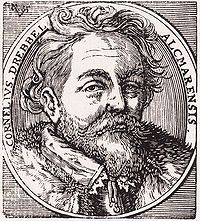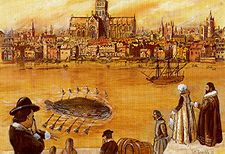- Cornelis Drebbel
-
Cornelis Drebbel 
Cornelis DrebbelBorn 1572
AlkmaarDied November 7, 1633
LondonEducation Hendrick Goltzius Occupation inventor & innovator Spouse Sophia Jansdochter Goltzius Children four Cornelis Jacobszoon Drebbel[1] (Alkmaar,1572 – London,November 7, 1633) was the Anglo-Dutch builder of the first navigable submarine in 1620. Drebbel was an innovator who contributed to the development of measurement and control systems, optics and chemistry.
Contents
Early life
Drebbel was born at Alkmaar, Holland. After some years at the Latin school in Alkmaar, around 1590, he attended the Academy in Haarlem, also located in North-Holland. Teachers at the Academy were Hendrick Goltzius, engraver, painter and humanist, Karel van Mander, painter, writer, humanist and Cornelis Corneliszoon of Haarlem. Cornelis became a skilled engraver.
In 1595 he married Sophia Jansdochter Goltzius, sister of Hendrick. They had 4 children. In 1600, Drebbel was in Middelburg where he built a fountain at the Noorderpoort. He met there with Hans Lippershey, spectacle maker and constructor of telescopes and his colleague Zacharias Jansen. There Drebbel learned lens grinding and optics. Around 1604 the Drebbel family moved to England, probably at the invitation of the new king, James I of England (VI of Scotland). Drebbel also worked at the masques, that are performed by and for the court. He was related to the court of Renaissance crown-prince Henry. In 1610 Drebbel and family were invited to come to the court of Emperor Rudolf II in Prague. After Rudolf's death in 1612, Drebbel went back to London. Unfortunately his patron prince Henry had also died and Drebbel was in financial trouble.
Drebbel's legacy
 First navigable submarine
First navigable submarine
In 1619 Drebbel designed and built telescopes and microscopes and was involved in a building project for the Duke of Buckingham. William Boreel, the Dutch Ambassador to England, mentions the microscope that was developed by Drebbel.[2] Drebbel became famous for his invention in 1621 of a microscope with two convex lenses. Several authors, including Christiaan Huygens assign the invention of the compound microscope to Drebbel. However, a Neapolitan, named Fontana, claimed the discovery for himself in 1618.[3] Other sources attribute the invention of the compound microscope directly to Hans Jansen and his son Zacharias around 1595.[4] In 1624 Galileo sent a Drebbel-type microscope to Federico Cesi (1585–1630), a wealthy noble man in Rome who used it to illustrate Apiarum, his book about bees.[5]
He also built the first navigable submarine in 1620 while working for the English Royal Navy.[6][7] Using William Bourne's design from 1578, he manufactured a steerable submarine with a leather-covered wooden frame. Between 1620 and 1624 Drebbel successfully built and tested two more submarines, each one bigger than the last. The final (third) model had 6 oars and could carry 16 passengers. This model was demonstrated to King James I in person and several thousand Londoners. The submarine stayed submerged for three hours and could travel from Westminster to Greenwich and back, cruising at a depth of from 12 to 15 feet (4 to 5 metres). Drebbel even took James in this submarine on a test dive beneath the Thames, making James I the first monarch to travel underwater.[8] This submarine was tested many times in the Thames, but it couldn't attract enough enthusiasm from the Admiralty and was never used in combat.
To re-oxygenate the air inside one or more of these submarines, he likely generated oxygen by heating nitre (potassium nitrate or sodium nitrate) in a metal pan to make it emit oxygen. That would also turn the nitrate into sodium or potassium oxide or hydroxide, which would tend to absorb carbon dioxide from the air around. That may explain how Drebbel's men were not affected by carbon dioxide build-up as much as would be expected. If so, he accidentally made a crude rebreather nearly three centuries before Fluess and Davis.[9] Drebbel had been taught by the alchemist Michael Sendivogius (1566–1636) (perhaps when both were at the court of Rudolf II) that warming nitre produced oxygen.[10] The most reliable source suggesting the use of oxygen is a note by Robert Boyle. In 1662 Boyle wrote that he had spoken with an excellent mathematician, who was still alive and had been on the submarine, who said that Drebbel had a chemical liquor that would replace that quintessence of air that was able to cherish the vital flame residing in the heart.
More recently it has been suggested that the contemporary accounts of the craft contained significant elements of exaggeration and it was at most a semi-submersible that was able to travel down the Thames by the force of the current.[11]
Drebbel's most famous written work was Een kort Tractaet van de Natuere der Elementen[12] (A short treatise of the nature of the elements) (Haarlem, 1621). He was also involved in the invention of mercury fulminate.[13] He had found out that mixtures of “spiritus vini” with mercury and silver in “aqua fortis” could explode [14]
Drebbel also invented a chicken incubator and a mercury thermostat that automatically kept it at a constant temperature. This is one of the first recorded feedback-controlled devices. He also developed and demonstrated a working air conditioning system. The invention of a working thermometer is also ascribed to Drebbel [15]
Towards the end of his life, in 1633, Drebbel was involved in a plan to drain the Fens around Cambridge, while living in near-poverty running an ale house in England. He died in London.
A small lunar crater Drebbel has been named after him.
A theory in Renaissance Magazine (issue #53, March 2007) speculates that the Voynich Manuscript may be Drebbel's cipher notebook on microscopy and alchemy.
Scarlet dye
The story goes that, while making a coloured liquid for a thermometer Cornelis dropped a flask of Aqua regia on a tin window sill, and discovered that stannous chloride makes the color of carmine much brighter and more durable. Though the inventor himself never made much money from his work, his daughters Anna and Catharina and his sons-in-law Abraham and Johannes Sibertus Kuffler set up a very successful dye works. One was set up in 1643 in Bow, London, and the resulting color was called bow dye.[16] The recipe for "color Kufflerianus" was kept a family secret and the new bright red color was all the rage in Europe.[17] [18]
Cultural references
A portrayal of Cornelis Drebbel and his submarine can be briefly seen in the film The Four Musketeers (1974). A small leatherclad submersible surfaces off the coast of England, and the top opens clamshell-wise revealing Cornelis Drebbel and the Duke of Buckingham.
Drebbel was honored in an episode of the cartoon Sealab 2021 during a submarine rescue of workers on a research station in the Arctic. A German U-boat captain fired a pistol in celebration at the mention of Drebbel, to shouts of, "Sieg Heil! Cornelis Drebbel!" Also, on the Sealab 2021 Season 3 DVD, Cornelis Drebbel has two DVD commentaries devoted to the story of his life. However, the first is highly inaccurate and the narrator of the second gets easily distracted, so much so that he spends most of the eleven minutes of commentary talking about the languages of northern Europe and the domestic policies of the Swiss.
In the Dutch Eighty Years War comic Gilles de Geus, Drebbel is a supporting character to the warhero Gilles. He is drawn as a crazy inventor, similar to Q in the James Bond series. His submarine plays a role in the comic.
Notes
- ^ "Drebbel's website www.drebbel.net". Sites.google.com. http://sites.google.com/site/ukdrebbel/. Retrieved 2010-08-06.
- ^ The Microscope – Its Design, Construction and Applications by F. S. Spiers. Books.google.be. 2008-11-30. ISBN 9781443725941. http://books.google.com/?id=kCSdiZcsWNsC&pg=PA5&dq=%22Cornelis+Drebbel%22+microscope#PPP1,M1. Retrieved 2010-08-06.
- ^ A Practical treatise on the use of the microscope by John Quekett, John Thomas Quekett. Books.google.be. 1852. http://books.google.com/?id=sHOanQkmpRcC&pg=PA1&dq=%22Cornelis+Drebbel%22+microscope#PPP1,M1. Retrieved 2010-08-06.
- ^ Under the microscope by William J. Croft. Books.google.be. 2006. ISBN 9789810237813. http://books.google.com/?id=Cr4_UJkBwYYC&pg=PR11&dq=%22Cornelis+Drebbel%22+microscope#PPP1,M1. Retrieved 2010-08-06.
- ^ The Dawn of Microscopy, by David Bardell © 2005 National Association of Biology Teachers.
- ^ Davis, RH (1955). Deep Diving and Submarine Operations (6th ed.). Tolworth, Surbiton, Surrey: Siebe Gorman & Company Ltd. p. 693.
- ^ Acott, C. (1999). "A brief history of diving and decompression illness.". South Pacific Underwater Medicine Society Journal 29 (2). ISSN 0813-1988. OCLC 16986801. http://archive.rubicon-foundation.org/6004. Retrieved 2009-03-17.
- ^ "King James VI and I". Royal.gov.uk. http://www.royal.gov.uk/OutPut/Page1673.asp. Retrieved 2010-08-06.
- ^ "Cornelis Drebbel: inventor of the submarine". Dutch Submarines. http://www.dutchsubmarines.com/specials/special_drebbel.htm. Retrieved 2008-02-23.
- ^ Michael Sendivogius, The Alchemical Letters of Michael Sendivogius to the Rosicrucian Society, Holmes Pub Group Llc, ISBN 155818404X
- ^ Gray, Edwyn (2003). Disasters of the Deep A Comprehensive Survey of Submarine Accidents & Disasters. Leo Cooper. p. 18. ISBN 0850529875.
- ^ Een Kort Tractaet van de Natuere der Elementen C. Drebbel, 1621
- ^ "Advanced Main Group Chemistry (I) – Rings, Chains, Clusters". 131.104.156.23. 2000-01-27. http://131.104.156.23/Lectures/CHEM_462/462_chapter_1.html. Retrieved 2010-08-06.
- ^ F. Kurzer: “Fulminic Acid in the History of Organic Chemistry“, J. Chem. Educ. 2000, 77, 851
- ^ "Scientific American. / Volume 5, Issue 50, August 31, 1850". Memory.loc.gov. http://memory.loc.gov/cgi-bin/query/r?ammem/ncps:@field(DOCID+@lit(ABF2204-0005-51))::. Retrieved 2010-08-06.
- ^ A history of inventions and discoveries, Volume 2,Johann Beckmann,1817
- ^ Amy Butler Greenfield,A Perfect Red,Harper Collins 2005,ISBN 0-06-052275-5
- ^ Diary of Samuel Pepys
References
- BBC bio
- Andrew Szydlo, Water that does not wet hands, (Polish Academy of Sciences, 1994)
- Brett McLaughlin, Cornelis Drebbel and the First Submarine (1997)
- L.E. Harris, The Two Netherlanders, Humphrey Bradley and Cornelis Drebbel (Cambridge, 1961)
- (Dutch) F.M. Jaeger, Cornelis Drebbel en zijne tijdgenooten, (Groningen, 1922)
- Who was Cornelis J. Drebbel ?
External links
Categories:- 1572 births
- 1633 deaths
- People from Alkmaar
- Dutch inventors
- Submarine pioneers
- Dutch Golden Age writers
Wikimedia Foundation. 2010.
